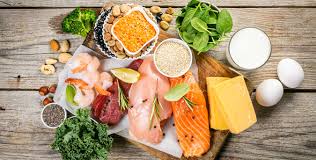Can protein be good for your heart? Absolutely—if you make the right choices. Selecting high-quality sources of protein and consuming the right amounts can benefit cardiovascular health, while some forms of protein may increase your risk for heart disease.
According to the American Heart Association, many people in the U.S. consume more protein than necessary, particularly from meats rich in saturated fats. Overconsumption of saturated fat can raise low-density lipoprotein (LDL) cholesterol, which contributes to heart disease. Additionally, processed meats—due to their high sodium content—have also been linked to cardiovascular risks, as noted by the Harvard School of Public Health.

Choosing the Right Proteins
Numerous studies suggest that swapping out high-fat meats for healthier protein options—such as fish, legumes, poultry, nuts, and low-fat dairy—may help lower the risk of heart disease. These alternative protein sources can support healthier blood pressure and cholesterol levels, and aid in maintaining a healthy body weight. Prioritizing them over red and processed meats may significantly reduce the likelihood of heart-related events like heart attacks and strokes.
A study published in Circulation found that frequent consumption of red meat raises the risk of coronary heart disease, while replacing it with other protein-rich foods can reduce that risk. For example:
-
A daily serving of nuts lowered heart disease risk by 30% compared to red meat.
-
Fish reduced the risk by 24%.
-
Poultry lowered it by 19%.
-
Low-fat dairy was associated with a 13% decrease in risk.
So, what are the best heart-smart protein sources—and how much should you be eating?
Top Heart-Healthy Protein Choices
1. Fish
Fish is one of the most heart-beneficial sources of protein. Aim to include one 3- to 6-ounce fillet or a 3-ounce can of fish in your diet each week. Salmon and tuna are standout choices.
-
Tuna: Wild, fresh, or canned in water, tuna offers lean protein and heart-protective omega-3 fatty acids. It’s also rich in B vitamins (B12, D, and niacin) and minerals like selenium. Opt for chunk light tuna to reduce mercury exposure, as albacore tends to contain higher levels.
-
Salmon: Whether wild-caught, fresh, or canned, salmon is a nutrient-dense protein option packed with omega-3s, phosphorus, potassium, and vitamins B6, B12, and D. Wild salmon tends to contain higher levels of beneficial fats. Try broiling salmon—10 minutes for every inch of thickness—for a healthy preparation.
Why fish over steak? A 6-ounce broiled porterhouse steak provides 40 grams of protein but also contains 38 grams of fat—14 of which are saturated. In contrast, the same amount of salmon delivers 34 grams of protein with just 18 grams of fat, only 4 grams of which are saturated.
2. Nuts and Legumes
Nuts, including walnuts, almonds, peanuts, pecans, and cashews, are excellent sources of heart-friendly protein and healthy fats.
Legumes—like lentils, peas, and beans—are another superb choice. They’re low in fat, free of cholesterol, and packed with protein. One cup of cooked lentils, for instance, offers 18 grams of protein and less than 1 gram of fat.
Natural nut butters (without added sugar or hydrogenated oils) are also heart-healthy in moderation—2 to 4 tablespoons per week is a good target.
3. Poultry
Skinless poultry, such as chicken and turkey, provides lean protein and has been associated with a 19% lower risk of heart disease when compared to red meat.
For healthier meals, skip fried chicken or processed patties. Instead, remove the skin and any visible fat before cooking, and opt for baking, broiling, or grilling.
4. Low-Fat Dairy
The CDC recommends choosing low-fat or fat-free options for dairy products like milk, cheese, yogurt, and sour cream. These offer quality protein without the added saturated fats found in full-fat versions.
As for eggs, while they’re not classified as dairy, egg whites or pasteurized egg white products are better options for heart health. However, studies suggest that whole eggs may not significantly affect cholesterol levels in most people. For about 70% of individuals, eating eggs has little to no impact on LDL cholesterol, although some people—called “hyper-responders”—may experience increases in a less dangerous LDL subtype known as pattern A.
How Much Protein Do You Really Need?
To support overall health—including cardiovascular health—protein should make up around 10–30% of your daily calorie intake. The general recommendations for protein consumption are:
-
Women (age 19+): 46 grams per day
-
Men (age 19+): 56 grams per day
Here’s how that can add up:
-
1 cup of milk = 8 grams of protein
-
6 ounces of salmon = 34 grams
-
1 cup of cooked beans = 16 grams
Combined, these foods meet the daily protein requirement for the average adult male.
Final Thoughts
Choosing heart-healthy proteins doesn’t mean sacrificing variety or taste. By favoring lean, nutrient-rich sources like fish, nuts, legumes, poultry, and low-fat dairy—and being mindful of how much you’re consuming—you can support both your heart and your overall wellness.
As part of a balanced eating plan, these smart protein choices can help reduce your risk of heart disease and promote long-term health.

I really appreciate this article’s focus on heart-healthy protein choices. It’s helpful to know what types and amounts to aim for.
I think the recommendations here are a bit too cautious—some people might need more protein for heart health than this article suggests.
Great read! Emphasizing plant-based proteins and moderation is key to maintaining heart health without overdoing it.